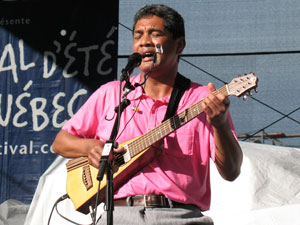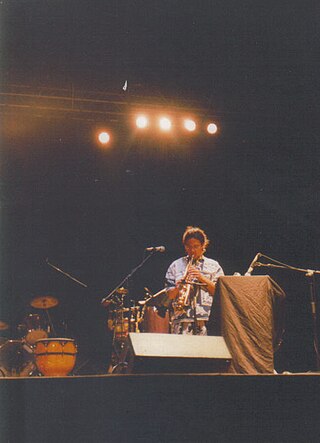
The flute is a member of a family of musical instruments in the woodwind group. Like all woodwinds, flutes are aerophones, producing sound with a vibrating column of air. Unlike woodwind instruments with reeds, a flute produces sound when the player's air flows across an opening. In the Hornbostel–Sachs classification system, flutes are edge-blown aerophones. A musician who plays the flute is called a flautist or flutist.

The saxophone is a type of single-reed woodwind instrument with a conical body, usually made of brass. As with all single-reed instruments, sound is produced when a reed on a mouthpiece vibrates to produce a sound wave inside the instrument's body. The pitch is controlled by opening and closing holes in the body to change the effective length of the tube. The holes are closed by leather pads attached to keys operated by the player. Saxophones are made in various sizes and are almost always treated as transposing instruments. A person who plays the saxophone is called a saxophonist or saxist.

A shakuhachi is a Japanese longitudinal, end-blown flute that is made of bamboo. The bamboo end-blown flute now known as the shakuhachi was developed in Japan in the 16th century and is called the fuke shakuhachi (普化尺八). A bamboo flute known as the kodai shakuhachi or gagaku shakuhachi (雅楽尺八) was derived from the Chinese xiao in the Nara period and died out in the 10th century. After a long blank period, the hitoyogiri shakuhachi (一節切尺八) appeared in the 15th century, and then in the 16th century, the fuke shakuhachi was developed in Japan. The fuke shakuhachi flourished in the 18th century during the Edo period, and eventually the hitoyogiri shakuhachi also died out. The fuke shakuhachi developed in Japan is longer and thicker than the kodai shakuhachi and has one finger hole less. It is longer and thicker than hitoyogiri shakuhachi and is superior in volume, range, scale and tone quality. Today, since the shakuhachi generally refers only to fuke shakuhachi, the theory that the shakuhachi is an instrument unique to Japan is widely accepted.

Yusef Abdul Lateef was an American jazz multi-instrumentalist, composer, and prominent figure among the Ahmadiyya Community in the United States.

As it is a country with many different tribes and ethnic groups, the music of Indonesia itself is also very diverse, coming in hundreds of different forms and styles. Every region has its own culture and art, and as a result traditional music from area to area also uniquely differs from one another. For example, each traditional music are often accompanied by their very own dance and theatre. Contemporary music scene have also been heavily shaped by various foreign influences, such as America, Britain, Japan, Korea, and India.

The highly diverse and distinctive music of Madagascar has been shaped by the musical traditions of Southeast Asia, Africa, Oceania, Arabia, England, France and the United States over time as indigenous people, immigrants, and colonists have made the island their home. Traditional instruments reflect these widespread origins: the mandoliny and kabosy owe their existence to the introduction of the guitar by early Arab or European seafarers, the ubiquitous djembe originated in mainland Africa and the valiha—the bamboo tube zither considered the national instrument of Madagascar—directly evolved from an earlier form of zither carried with the first Austronesian settlers on their outrigger canoes.

The xaphoon is a chromatic keyless single-reed woodwind instrument. It has a closed cylindrical bore and a very slightly flared bell. The xaphoon has a full chromatic range of two octaves, and overblows at the twelfth like the clarinet.

The valiha is a tube zither from Madagascar made from a species of local bamboo; it is considered the "national instrument" of Madagascar. The term is also used to describe a number of related zithers of differing shapes and materials.

The Malagasy are a group of Austronesian-speaking ethnic groups indigenous to the island country of Madagascar. Traditionally, the population have been divided into ethnic groups. Examples include "Highlander" groups such as the Merina and Betsileo of the central highlands around Antananarivo, Alaotra (Ambatondrazaka) and Fianarantsoa, and the "coastal dwellers" such as the Sakalava, Bara, Vezo, Betsimisaraka, Mahafaly, etc.

The mouthpiece of a woodwind instrument is that part of the instrument which is placed partly in the player's mouth. Single-reed instruments, capped double-reed instruments, and fipple flutes have mouthpieces while exposed double-reed instruments and open flutes do not. The characteristics of a mouthpiece and reed can play a significant role on the sound of the instrument.

Solo Razafindrakoto known as Solorazaf is a Malagasy guitarist born in France. His roots are both situated in Madagascar. His musical style is very much influenced by these two different cultures and he then created a very personal musical style based on Malagasy traditional music.

Philibert Rabezoza, better known by the name Rakoto Frah, was a flautist and composer of traditional music of the central highlands of Madagascar. Born in 1923 near the capital city of Antananarivo to a poor rural family, Rakoto Frah surmounted the challenges posed by his underprivileged origins to become the most acclaimed 20th century performer of the sodina flute, one of the oldest traditional instruments on the island. Through frequent international concerts and music festival performances, he promoted the music of the highlands of Madagascar and became one of the most famous Malagasy artists, both within Madagascar and on the world music scene.

Nicolas Vatomanga Andrianaivo Rakotovao, known as Nicolas Vatomanga is a Malagasy saxophonist, flutist, bandleader and composer. His music combines elements of jazz, blues and traditional musics of Madagascar, including: the hira gasy of the Centre, the beko from the South and the salegy from the North of the Great Island.

Jazz flute is the use of the flute in jazz music. While flutes were sometimes played in ragtime and early jazz ensembles, the flute became established as a jazz instrument in the 1950s. It is now widely used in ensembles and by soloists. The modern Boehm system transverse concert flute is commonly used in jazz playing; other members of the same family are used, such as the alto flute in G. Ethnic and other flutes, such as bamboo flutes, have also been used in jazz.

Paul Bert Rahasimanana, better known as Rossy, is a Malagasy singer and songwriter, generally considered the most popular Malagasy artist of the 1990s. Beginning his musical career as an accordionist and singer within a traditional hira gasy musical troupe, Rossy innovated a fusion of hira gasy instrumentation and vocal style with contemporary rock, funk and folk sounds to create a uniquely Malagasy genre of contemporary popular music. Rossy actively promoted former president Didier Ratsiraka through concert performances throughout his presidency and served within the Ministry of Culture to promote artists' rights and copyright law. When Ratsiraka fell into disfavor following the contentious 2001 Malagasy presidential elections, Rossy went into self-imposed exile in France. He returned to the island to give concerts beginning in 2008 and enjoyed enormous popularity despite six years of absence, setting an unbroken record of 35,000 tickets sold for a performance given that year. His compositions and style are frequently associated with the Ratsiraka socialist period and commonly evoke a sense of nostalgia among Malagasy fans.

Erick Manana is an acoustic guitarist, singer and songwriter from Madagascar. He often performs in a duo or as a solo artist, singing in accompaniment to his acoustic guitar in the ba-gasy genre that gained prominence in the central highlands of Madagascar in the 1930s. He began to learn to play guitar and sing in the ba-gasy style from his grandfather at the age of five. In 1979 he left Madagascar to settle in France and currently lives in Bordeaux. His professional career as a musician began in 1982 as a member of Lolo sy ny Tariny. He recorded his first solo album in 1996. He was a member of the group Feo-Gasy alongside the celebrated sodina player Rakoto Frah, and together the group toured Europe several times, promoting the traditional music of the central highlands of Madagascar. He has worked on a variety of collaborative projects, recording singles and performing with established artists such as Regis Gizavo and Solorazaf, and young breakthrough stars like Aina Quash. Most recently, Manana formed a group with valiha player Justin Vali and other prominent Malagasy artists in the Malagasy All Stars.

Mahaleo is a folk-pop band from Madagascar that is widely viewed as the most popular Malagasy group of all time. The band was founded by Dama with six of his classmates after first performing together during the rotaka student protests at their high school on 13 May 1972. Mahaleo's lyrics draw upon the indirect language of traditional hainteny and ohabolana to expose contemporary political and social issues and invite listeners to identify their own solutions.
Feo-Gasy is a band from Madagascar that perform a traditional ba-gasy music of the Merina people of the rural central highlands around the capital city of Antananarivo. The band was founded in 1994 by superstar guitarist Erick Manana and featured until his 2001 death the iconic sodina player Rakoto Frah, the only Malagasy musician ever to be featured on the local currency. The group was originally composed of the acoustic guitarist and singer Erick Manana, the sodina player and singer Rakoto Frah, singer and guitarist Jean-Colbert Ranaivoarison ("Rakôly"), vocalists Famantsoa Rajaonarison ("Fafa") and François-Daniel Rabeanirainy ("Beny"), and valiha player Bariliva Rasoavatsara, who died in December 2012.

Albert Rakoto Ratsimamanga was a Malagasy physician, biochemist and diplomat. Born into a disgraced royal family; Ratsimamanga trained as a doctor of exotic medicine in French Madagascar and France, where he pioneered modern nutraceuticals. Ratsimamanga returned to Madagascar and, with his wife, Suzanne Urverg-Ratsimamanga, in 1957, established the Malagasy Institute of Applied Research which specialised in herbal medicine.


















